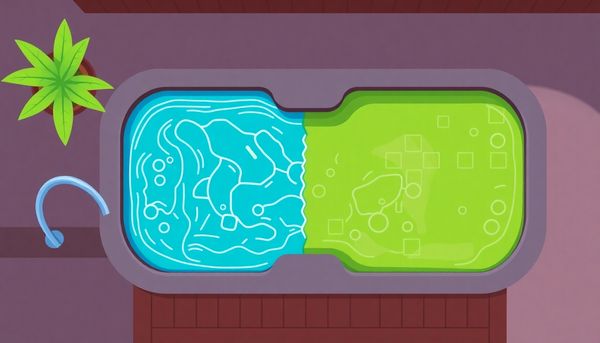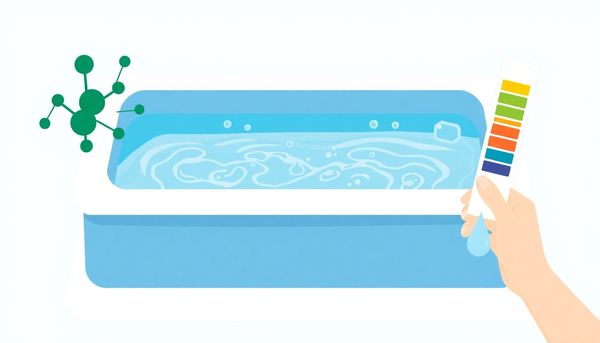Master Hot Tub Water Testing: Essential Tips for Safe Soaks
January 22th, 2024
January 22th, 2024
Beneath the twinkling stars, a hot tub offers a pocket of relaxation, warming the spirit and soothing tired muscles. Yet, maintaining this oasis is no simple task. At the heart of it lies a crucial, often overlooked element: water testing. This essential practice ensures not only the clarity of the water but also its safety and comfort.
Water testing might not hold the glamour of a luxury spa, but it is the linchpin of a healthy hot tub experience. Remember the time when my friend decided to skip the testing, only to find her once-inviting retreat transformed into a frothy cauldron of grime? It wasn't just the murkiness that was alarming; such neglect can lead to skin irritations and even respiratory issues.
Every hot tub enthusiast should appreciate that water quality is a delicate balance. Factors such as pH levels, sanitizer concentration, and calcium hardness are few among many that require regular monitoring. These variables are necessary for keeping bacteria at bay, ensuring the longevity of the hot tub's components, and maintaining that silky water feel.
In this guide, you won't find a dull recitation of facts. Instead, expect a journey through the intricacies of water chemistry, bolstered by practical tips and personal insights to empower you with both knowledge and confidence. With the right tools and understanding, anyone can transform their hot tub into a sanctuary that is as pristine as it is inviting.

Ever found yourself wrinkling your nose at the sight of murky hot tub water? It’s a common sight when neglect sets in, but thankfully, it’s an easily solvable mystery. The sleuthing begins with understanding your water's chemistry—something you can achieve with the trusty hot tub test strips. These little pieces of paper are not just tools; they are your guide to maintaining pristine waters.
Each time you reach for those test strips, you’re engaging in a vital ritual of hot tub care. Dip a strip into the water, away from the jets, aiming for the heart of your spa. This small act ensures you’re getting an accurate picture of the water's condition. Once you retrieve your strip, compare its color codes against the guide that comes with it. This will reveal the levels of pH, alkalinity, and sanitizers like chlorine or bromine.
When I first started, I underestimated the importance of regular testing. One lazy weekend I found the water was more swamp than spa. Lesson learned—it’s not just about the chemicals you add but also the vigilance you maintain. Regular testing, at least once a week, becomes second nature. If your tub sees frequent use or if there’s been heavy rain, those strips are your first responders, offering a clear first step towards rejuvenation. Embrace this habit, and your hot tub will reward you with crystal-clear serenity.
Achieving the right balance in your hot tub water is akin to tuning a musical instrument—each note must be precise to create a harmonious experience. A balanced hot tub promises not just clarity in appearance, but also ensures the longevity of your spa equipment. Take, for instance, my neighbor who once neglected balancing only to find a sizable calcium deposit in her system, resulting in costly repairs. That’s a symphony no one wants to conduct.
Begin with pH levels; they are the backbone of your water’s health. Strive for a range of 7.4 to 7.6, as this optimal level prevents corrosion and scaling. Regular testing is crucial, especially after heavy use or significant weather events like rain, which can alter chemical levels swiftly. If you see murky waters, this could be a sign of imbalance. Swift intervention with the right chemicals can prevent small issues from escalating.
Alkalinity, the unsung hero, acts as a buffer for pH levels. Too low, and your pH may fluctuate wildly. Too high, and your water becomes a breeding ground for scale. Aim for a range between 80 and 120 ppm. Testing weekly not only maintains water clarity but also protects your investment. Should hardness levels rise, resulting in a gritty spa surface, a calcium reducer will be your savior.
By prioritizing regular checks and adjustments, you’ll master the art of water balance, creating a perfectly serene and enjoyable spa experience.
For the uninitiated, hot tub water testing might appear as daunting as deciphering a foreign language. Yet, once familiar with the array of testing techniques, it becomes second nature. Begin with understanding the essential role of test strips. These simple tools are like the unsung heroes of spa maintenance. They provide insight into your water's pH, alkalinity, and chlorine levels in a matter of seconds. It's like having a mini lab in your backyard.
When using test strips, precision is key. Collect your sample from the center of the tub, avoiding areas near the jets to ensure an accurate reading. My friend Lisa, a hot tub enthusiast, swears by holding the strip against a white background to better discern those subtle color changes. It might seem trivial, but this little trick has saved her countless headaches.
Moreover, don't overlook the power of liquid test kits, especially for more detailed metal analysis. These kits can reveal hidden elements like iron and copper, which are notorious for causing unsightly stains. While they require a bit more effort—matching color shades is no foolproof task—they offer a deeper dive into your water's chemistry.
Balancing simplicity and thoroughness, consistent testing can preempt costly repairs. Whether it's a weekly ritual or a significant monthly check-up at your local dealer, mastering testing techniques ensures your hot tub remains a sanctuary of relaxation, free from unwelcome surprises.
An evening soak in a hot tub can be a blissful escape, but imagine gazing at the water and spotting an inexplicable green tint. Often, the culprit behind such discoloration lies in metal contaminants. Metals like copper and iron are stealthy intruders, seeping into your tub either from the water source or corroded plumbing systems. A simple metal test can pinpoint these offenders, so it's wise to include metal-testing strips in your hot tub maintenance arsenal.
In my own experience, a seemingly innocuous brown tinge turned out to be iron, sneaking in from our well water. Regular testing revealed the necessity of a preventative approach. While standard test strips are essential for monitoring pH and chlorine, specialized strips or kits for metals offer an extra layer of protection. They not only identify the presence of metals but also help in determining the concentration levels, crucial for taking effective action.
Once you've identified a metal issue, a sequestrant can be your best ally. These compounds bond with metals, preventing them from oxidizing and causing unsightly stains. However, remember that while sequestrants help manage metal levels, they don’t remove them entirely. Consistent testing and a good sequestrant routine can keep your hot tub water crystal clear, making sure your relaxation isn't interrupted by unexpected metallic visitors. Balancing metal levels ensures that your spa experience remains as pristine as your intentions for a peaceful soak.

Balancing chemical levels in your hot tub is like orchestrating a symphony of relaxation. Achieving that perfect harmony between pH, alkalinity, and sanitizer levels ensures that your soak is both safe and soothing. Start with pH, which should grace the 7.4 to 7.6 range. A close friend once complained about itchy skin after a dip; we adjusted her tub's pH from a low 6.8 to a perfect 7.5, and the itch was gone. It turns out, even minor shifts can make a big difference.
Next, look at total alkalinity, which acts as a pH buffer. Keep it between 80 and 120 ppm. A colleague once struggled with fluctuating pH levels until we discovered his alkalinity was out of whack. After balancing it, his spa maintenance became significantly smoother. Alkalinity aids in stabilizing pH and preventing drastic changes that can cause discomfort or damage the tub.
Chlorine or bromine levels should also be carefully monitored. A friend once noticed an odd smell emanating from her tub; it was a sanitizer imbalance. Bringing her chlorine up to the recommended 3-5 ppm resolved it quickly, restoring her tub’s inviting clarity. The sweet spot keeps bacteria at bay without overwhelming your senses.
Remember, test and adjust weekly, or more often with frequent use or weather changes. Regular checks prevent imbalances and extend the life of your hot tub, ensuring every soak is as refreshing as a mountain spring.
A familiar scene unfolds: the hot tub beckons, yet something about the water doesn’t seem right. As you peer into the depths, a subtle cloudiness or a tint of green stirs concern. These signs hint at an imbalance, urging the necessity of regular water testing. This isn’t just a chore; it’s a ritual that ensures your soak remains pleasurable and safe.
Testing your hot tub water weekly is essential, much like tending to a cherished plant that needs consistent care. For frequent users or after substantial rainfall, consider increasing the frequency. A personal habit might include incorporating testing as part of your morning routine, similar to brewing your coffee. The test strips act as your guide, revealing crucial information about pH levels, alkalinity, and chlorine. Specialty strips can extend this insight to metals like iron and copper, which might otherwise go undetected.
Professional testing at a store once a month adds an extra layer of assurance. These experts can detect minute imbalances you might miss, safeguarding your spa from potential damage. Remember, catching these issues early prevents costly repairs down the line—an investment in peace of mind and longevity for your hot tub. Keep your water crystal clear, and you’ll always step into a tub that promises relaxation and rejuvenation.
Metal contamination in your hot tub can pose a sneaky challenge, often lurking beneath the surface until cloudiness or stubborn stains give it away. It's like that unexpected guest at a party—unwanted yet undeniably present. Metals such as iron and copper, usually introduced through your water source or corroded spa components, gradually accumulate and create unsavory conditions. The result? Water that turns cloudy, appears discolored, or leaves unsightly marks on your spa shell.
Consider the experience of a friend who lives in a rural area reliant on well water. They initially found their hot tub water was staining—a classic sign of high iron content. A specialized test kit that detects metals swiftly solved the mystery, highlighting the importance of testing beyond the basic chemical balance. While standard test strips cover essentials like pH and chlorine, you'll need ones crafted for metal detection to catch culprits like copper and iron.
Once you identify metal contamination, a sequestrant becomes your ally. These liquid agents bind with metals, preventing oxidation and enabling their removal via the hot tub filter. Remember, prevention is better than cure. Regularly test for metals, especially if your water source is suspect, and consider using a hose filter when refilling. Through diligent testing and maintenance, you'll ensure your tub remains a sanctuary, free from the woes of metal-induced troubles.
Keeping a hot tub in top shape isn't just about enjoying warm, relaxing soaks. It's also about understanding and managing the chemistry of your water, especially when it comes to calcium hardness. When calcium levels in your hot tub water drift out of balance, the effects can be both visible and costly. High calcium hardness leads to scale formation, a crusty layer that can clog filters, damage heaters, and mar the tub's surface. On the flip side, if calcium levels are too low, you risk corrosion, which slowly eats away at your equipment and fixtures.
Checking calcium hardness should be a regular part of your hot tub maintenance ritual. For precision, opt for a professional-grade liquid testing kit rather than relying solely on standard test strips. Your aim should be to maintain calcium levels between 175 and 250 parts per million (ppm). This range helps ensure your hot tub operates smoothly without the threat of scale or corrosion.
If you find yourself dealing with hard water, consider using a scale inhibitor. This addition to your maintenance routine helps prevent scale by binding with calcium ions before they can form that annoying crust. On the other hand, if you're battling low calcium, a calcium hardness increaser can restore balance and protect your tub's longevity. Remember, maintaining the right calcium levels not only preserves your hot tub’s functionality but also extends its life, letting you enjoy many soothing evenings ahead.

Navigating the world of hot tub test strips can feel like stepping into a colorful, albeit necessary, labyrinth. With so many options available, choosing the right test strips is like selecting the perfect book from an extensive library. Each strip tells a story about your water's health, revealing levels of pH, alkalinity, and chlorine within seconds. Some strips are versatile, checking for seven different chemistries at once, while others are specialized, focusing on metals like copper and iron. The key is understanding what your hot tub needs based on your water source and its unique challenges.
Consider your water's origin: well water might mean higher metal content, while city water often presents hardness issues from calcium and magnesium. Knowing this can guide you toward strips that address your specific concerns. Specialty strips for metals are essential if your water tends to stain or cloud, whereas standard strips suffice for routine checks of pH and chlorine.
Think of your test strips as your hot tub's personal health kit. They're not just tools but allies in maintaining a pristine soak. When choosing, factor in durability, ease of use, and the specific parameters you need to monitor. A little bit of research and the right selection can make testing a quick and effective ritual, ensuring that your hot tub remains a crystal-clear oasis.
Grabbing a water sample from your hot tub might seem straightforward, but there’s a bit of an art to it. When I first started testing my hot tub, I learned the hard way that the accuracy of your results can hinge on how you take that sample. You want to ensure you’re capturing a true representation of the water, not just a snapshot of what's near the jets or skimmer, where chemical levels can be misleadingly higher or lower.
Begin by submerging a clean container into the water, aiming for the middle section, away from the influence of the jets. This approach avoids collecting water that might have just been dosed with chemicals, giving you a more consistent reading of the overall balance. Personally, I use a simple plastic cup for this task, but anything clean and easy to handle will do the job nicely.
Timing also plays a role—sample when the hot tub has been running for at least 15 minutes. This allows chemicals to circulate properly, ensuring the sample you take is a fair reflection of the water’s condition. When I started following this routine, the clarity of my results improved significantly, saving me both time and the minor frustration of retesting.
Remember, regularly taking precise samples and testing helps maintain that pristine, inviting water quality, reducing the likelihood of troublesome imbalances. With a consistent method, your hot tub can remain a worry-free oasis.
Deciphering the chemistry of hot tub water might sound like a daunting task, but it’s more about consistency than complexity. Your arsenal for clear, inviting water begins with a few essential test components. First, reliable test strips are your go-to, checking the fundamental parameters: pH, alkalinity, and sanitizer levels like chlorine or bromine. These strips provide a quick snapshot of your water’s health, allowing you to make necessary adjustments promptly.
Beyond the basics, water hardness is another crucial element. If your water source tends to be hard or soft, testing for calcium levels becomes key to preventing scale build-up or corrosion. Specialty strips or liquid test kits designed for calcium hardness help you maintain this balance, safeguarding your spa’s components over time.
For those wary of metals lurking in their soak, consider a test for iron and copper, particularly if you’re filling your tub with well water. Metals can stain and cloud the water, so detecting them early with dedicated test kits can save you from future headaches.
Finally, if you own a saltwater hot tub, add salt test strips to your toolkit. Maintaining the right salt levels ensures efficient chlorine generation, keeping your water sanitized and your system functioning optimally.
Each of these test components forms part of a larger strategy to maintain sparkling, balanced water. Regular checks not only prolong the life of your hot tub but also enhance your soaking experience, letting you enjoy those bubbling moments worry-free.
Harnessing the right tools for testing your hot tub water is akin to choosing the perfect pair of glasses—it sharpens your view and helps maintain clarity. Your hot tub, a sanctuary of relaxation, deserves to be filled with pristine water, free from imbalances that could dampen your experience. The first step in this maintenance journey involves selecting the appropriate testing tools, and here, specificity is key.
Spa test strips are the unsung heroes of water testing, offering a quick snapshot of various chemical levels such as pH, alkalinity, and chlorine. These strips are not only affordable but also user-friendly, allowing even the most novice hot tub owner to get accurate readings without breaking a sweat. For those looking to dive deeper, liquid test kits provide detailed insights. Although they require a bit more finesse and time, they can reveal subtleties that strips might miss.
Consider a scenario where your water source contains high levels of metals like iron or copper. In such cases, specialized strips or kits that target these elements are invaluable. Having the right tools at your disposal ensures you can swiftly address issues before they escalate.
Remember, the reliability of your testing tools significantly influences the effectiveness of your water management. Regular testing, coupled with the right instruments, will keep your hot tub a relaxing retreat, free from unwanted surprises.

Metal buildup in your hot tub can turn a serene soak into a frustrating endeavor. Metals like iron and copper can cause unsightly stains and murky water, making your spa experience less than luxurious. Let's unravel how to manage and prevent these pesky metal issues.
First, understanding your water source is crucial. If your water comes from a well, it’s more likely to contain higher levels of metals like iron and copper. City water, though treated, can still contribute to metal buildup, especially if it's hard water containing calcium and magnesium. These metals can accumulate over time, leaving deposits that stain your tub and disrupt chemical balance.
Using specialized test strips designed for metals can be your first line of defense. These strips give quick readings, helping you detect any abnormal levels before they lead to more significant problems. Testing monthly is typically sufficient unless you notice discoloration or other signs of metal presence, in which case more frequent checks might be necessary.
Implementing a metal sequestrant can also help. These chemicals bind with metals in the water, preventing them from causing stains or scale. However, remember that sequestrants don’t remove metals; they merely suspend them, so regular use is essential.
Lastly, consider installing a hose filter when filling your hot tub. This tool acts as a barrier, capturing metals before they reach your spa. By being proactive and testing regularly, you can maintain a sparkling clean hot tub and avoid the hassle of metal buildup.
A splash of prevention is always better than a deluge of repair when it comes to hot tub maintenance. Regular water testing is the unsung hero of spa upkeep, ensuring that your relaxation haven remains both inviting and safe. Testing your hot tub water isn't merely a box to tick; it's a critical habit that prevents potential issues from escalating into costly repairs.
Consider the myriad elements at play in your hot tub. First, there's the pH level, which should hover between 7.4 and 7.6. Stray outside those lines, and you risk irritating your skin or damaging your spa equipment. Then, there's alkalinity, which acts as the water's bodyguard, preventing sudden pH shifts. Finally, sanitizers like chlorine or bromine are the defenders against bacteria and germs.
Weekly testing is your best friend, especially if your hot tub sees frequent use or endures weather changes. But don't just rely on home test strips. Once a month, take a water sample to a professional for a more detailed analysis. This practice catches any lurking metal issues, like iron or copper, that might not show up in standard tests.
Remember, water chemistry is a dynamic dance. By making regular water testing a part of your routine, you're ensuring that every dip in your hot tub is as refreshing and trouble-free as the last. This small but mighty step not only prolongs the life of your hot tub but also enhances your soaking experience.
Navigating the delicate balance of hot tub chemistry can feel like orchestrating a symphony, where each element must harmonize perfectly. Specialty test strips are the virtuosos in this ensemble, offering insights beyond basic pH and chlorine levels. These strips delve into the complexities of your water, detecting unexpected intruders like metals and salt that often lurk unnoticed.
A friend of mine once discovered mysterious copper stains on their pristine white spa shell. It turned out their water source was the culprit, loaded with minerals invisible to the naked eye. Specialty strips revealed this hidden issue, allowing for a swift remedy before any permanent damage occurred. Such strips are indispensable, especially for those reliant on well water, as they can screen for iron and copper, averting both aesthetic and mechanical calamities.
Each type of specialty strip tackles different concerns. Metal test strips detect iron and copper, while other strips measure salt levels, crucial if you use a saltwater chlorinator. They’re simple to operate—immerse the strip, wait for a reaction, then compare the results to a color chart. This effortless process can prevent costly repairs and prolong the life of your hot tub.
Incorporating specialty test strips into your regular maintenance routine transforms water testing from a mundane task into a proactive strategy, ensuring that your soak remains as serene and worry-free as possible.
When your hot tub water displays a shade of green rather than a sparkling blue, it might be time to tackle the meddling metals lurking beneath the surface. Metals like iron and copper can subtly sneak their way into your spa, especially if you’re drawing from a well or dealing with aging plumbing. These elements often manifest as cloudy water or unsightly stains, detracting from your spa’s appeal.
To combat this, first, bring out those specialized metal test strips. These handy tools, designed specifically for detecting iron and copper, are your first line of defense. I remember the first time I used them—marveling at how a simple strip could reveal the unseen complexities of my spa water.
Once you've identified a metal issue, a sequestrant is your ally. This liquid binds with metals in your tub, preventing them from oxidizing and staining surfaces. It’s not a permanent fix—think of it as a diligent helper that needs regular reapplication to keep working efficiently. Remember, it doesn’t remove metals but keeps them suspended until your filtration system can catch them.
For a more preventative strategy, consider a hose filter when filling your tub. It acts as a gatekeeper, reducing the amount of metals entering your spa in the first place. With these strategies, you'll maintain a clear and inviting oasis, free from the shadows of iron and copper.

If you've ever noticed a chalky residue clinging to your hot tub's surfaces or, conversely, found your spa's fittings corroding, your calcium hardness might be off-kilter. This critical element in hot tub maintenance refers to the concentration of dissolved calcium in the water. Too much, and your spa could resemble a mini stalactite haven; too little, and corrosion may soon be your unwelcome guest.
Ensuring the right balance, typically between 175 and 250 parts per million (ppm), is key to maintaining your hot tub's health. Regularly testing your water is crucial, especially if your home has hard water, characterized by higher levels of calcium and magnesium. Investing in a quality water testing kit can save you from potential headaches—and repairs—down the line.
Personal experience has taught me that neglecting this simple task can lead to costly repairs. I once skipped testing for a few weeks, thinking everything looked fine. When I finally checked, I discovered my calcium levels had skyrocketed, leaving me with unsightly scale and a day spent scrubbing.
Don't rely solely on appearance; the water may seem fine but still harbor imbalance. By monitoring calcium hardness at least once a month, or more frequently if your water source tends to be hard or soft, you can enjoy a worry-free soak. Remember, regular maintenance is your best defense against hot tub woes.
Picture yourself preparing for a relaxing soak, only to find your hot tub water looking less inviting than anticipated. Instead of diving straight into a chemical cocktail mix, the secret lies in understanding your water's unique personality by testing it regularly. This routine isn’t just a chore; it's a ritual that ensures your private oasis remains as welcoming as ever.
Testing is more than a basic task—it's like a health check-up for your tub. By regularly measuring pH, alkalinity, calcium hardness, and sanitizer levels with test strips or kits, you prevent imbalances that could lead to cloudy water or skin irritation. Imagine using speciality test strips to discover hidden metals like iron and copper, unseen culprits of discoloration and tub stains. A friend of mine once ignored this and ended up with stubborn, rusty streaks that took ages to clear.
Each week, as you dip the strip into the warm water, you’re not just maintaining a machine; you’re safeguarding your sanctuary. Over time, you’ll tweak and perfect your chemical routine, adapting it to seasonal changes and usage patterns. By making testing a habit, you cultivate an intimate understanding of your hot tub's needs, avoiding costly repairs and ensuring every soak is as soothing as intended. Consider it an investment in peace of mind, and enjoy the satisfaction that comes from truly knowing your water.
When it comes to maintaining the sparkle in your hot tub, adding a metal-sequestrant can be a game-changer. Remember that time your favorite swimsuit mysteriously turned greenish after a soak, and you scratched your head wondering what went wrong? Often, this discoloration is due to metals like iron and copper lurking in your water. These metals can not only stain your swimwear but also tarnish the inviting appearance of your hot tub.
Metal-sequestrants come to the rescue by binding with these metals, keeping them from oxidizing and causing those unsightly stains. They don’t eliminate the metals, but they do prevent them from reacting with other elements in the water. This binding action allows metals to be trapped by your hot tub's filter, making it easier to maintain clear, inviting water.
If your water source is high in metal content, regular use of a sequestrant is essential. I remember my friend Sarah complaining about persistent water cloudiness until she started using a sequestrant as part of her routine. Since then, her hot tub has not only stayed clear but also more pleasant to be in.
Using a metal-sequestrant requires following the manufacturer's instructions carefully. And if you're unsure about your water's metal levels, consider getting a kit that tests specifically for iron and copper. This proactive approach ensures you enjoy a stain-free, luxurious soak every time.

This article provided insights into maintaining your pool. Start your pool care journey today!
Want to become a pool maintenance expert? Our free Pool School course covers everything you need to know about pool care. From basic maintenance to advanced troubleshooting, you'll learn how to:
Join over 10,000 pool owners who have already transformed their pool care routine. Get started with our free Pool School course today!